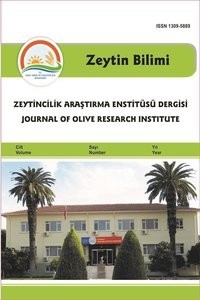Sofralık Zeytinin Besin Öğeleri, Duyusal Karakterizasyonu ve İşleme Yöntemleri Arasındaki Etkileşimler
Zeytinin özellikle Akdeniz toplumunun beslenmesinde, ekonomisinde ve kültüründe önemli bir role sahip olduğu bilinmektedir. Zeytin, doğasından gelen özellikler ve özellikle içerdiği acılık nedeniyle işlenmeden doğrudan tüketilememektedir. Sofralık zeytinin duyusal özelliğinin ortaya çıkmasında, bileşiminde bulunan maddelerin ve işleme yöntemlerinin etkili olduğu düşünülmektedir. Bu derlemeyle zeytinin besin öğeleri, işleme yöntemleri ve duyusal özellikleri arasındaki etkileşimler ortaya konmaya çalışılmıştır. İnsan sağlığı üzerinde olumlu etkileri olduğu bildirilen fenolik bileşikler, zeytinin yağ oranı ve fermente olabilir maddelerin son ürünün duyusal özelliklerinin gelişimini tayin ettiği ifade edilmektedir. Sofralık zeytinlerin tüketiminde görünüş, renk ve sertlik özelliklerinin önemli bir yere sahip olduğu görülmektedir. Yüksek tuz oranı beğeniyi düşürmektedir. Tatlandırma işlemleri sırasında mayaların, fermantasyonun son ürününün duyusal karakteri üzerinde önemli bir rol oynayabileceği ifade edilmektedir. Tüketilebilirliği etkileyen duyusal özellikler ilk olarak renk ve doku özellikleriyle ön plana çıkarken, acı tadın sorumlusu olan fenolik bileşikler, yağ oranı, fermente olabilir maddeler, asit ve tuz oranları, mikrobiyolojik gelişmeler sonucu oluşan metabolitler sofralık zeytinlerin duyusal karakterini ortaya koymaktadır. Bu özelliklerin bir kısmı zeytinin doğasından gelirken bir kısmı da tatlandırma ve sonrasında yapılan depolama işlemleri sonucu sofralık zeytinin duyusal özelliği olarak ortaya çıkmaktadır
Anahtar Kelimeler:
Sofralık zeytin, besin öğeleri, duyusal analiz, etkileşim
Interactions Between of Processing Methods, Sensory Properties and Nutrition Ingredients of Table Olives
Olive has been reported to have an important role especially in the nutrition, economy and culture of Mediterranean society. Olive cannot be directly consumption because it contains bitterness and other features. It is considered that nutrition ingredients of olive and processing methods are affect on sensory attributes of table olives. The aim of this review proves interactions between nutrition ingredients, processing methods and sensory attributes. Phenolic compounds that reported positive effects on human health, oil content of olive and substances that can be fermented are developed organoleptic properties of last crop. Appearance, color and hardness properties were found to have an important role in the consumption of table olives. High salt lowers the rate of admiration. Yeasts may play an important role on the sensory character of final product in the during table olive processing. Color, hardness, softness, and texture features are firstly effect on the sensory characteristics, while the phenolic compounds responsible for bitter taste, oil content, substances that can be fermented, acid and salt ratios, microbial metabolites develop the sensory character of table olives. Some of these features are caused by the some of nature properties of the olives, and other some features are emerged as a sensory properties resulting of the sweetening and storage process
Keywords:
Table olive, nutrition ingredient, sensory analysis, interaction,
- ISSN: 1309-5889
- Başlangıç: 2010
- Yayıncı: Zeytincilik Araştırma Enstitüsü Müdürlüğü - İZMİR
